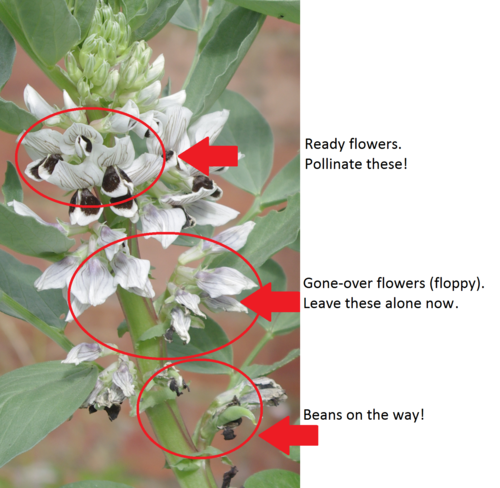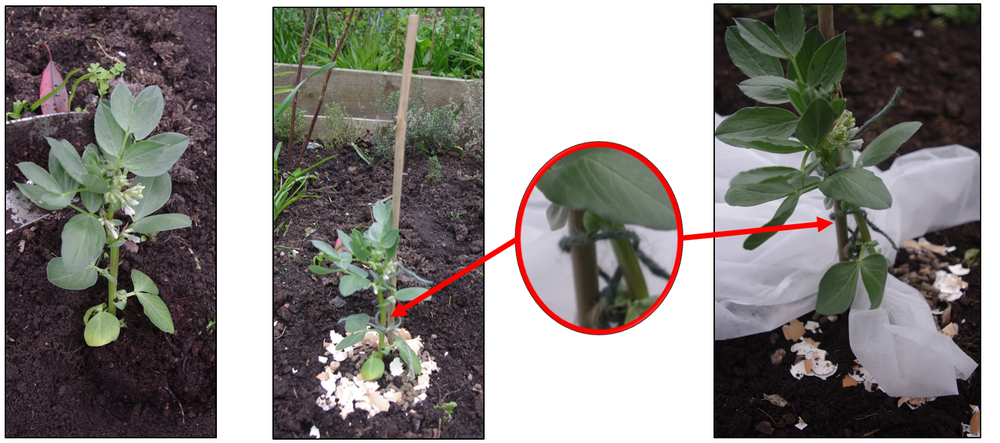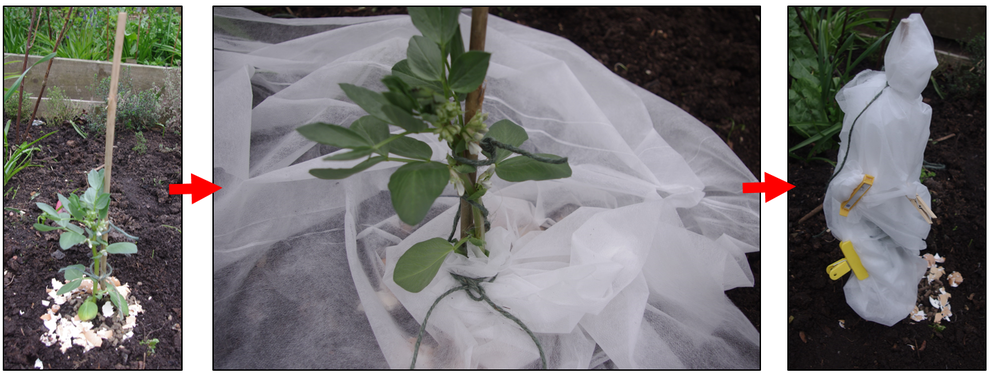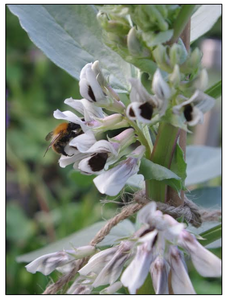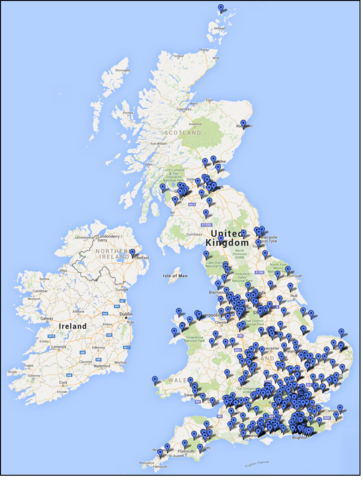
Hullo, folks! This site was the project website for my PhD at Sussex University, 2013-17, bringing together all the citizen science projects that I undertook as part of that thesis. It will remain up for archive purposes (plus, the advice sheets etc are still fine).
To see what I'm up to now, and take part in any of the new projects I start up, please check out the new site:
And we are done! All the data collection for 2016 is in; all beans harvested and hopefully enjoyed after their weighing.
(I think. Possibly one or two more to arrive by post?)
I'm in the middle of wrapping up my other fieldwork right now, but will get on with curating and analysing asap. With three years of data under the project's proverbial belt, I'm hoping to get some wider analysis done as well once everything is sorted out - and I will be sure to let everyone know any findings.
A great many thanks to my volunteers throughout this work; I quite literally could not have done this without you all, and I hope you've found it fun, and interesting, to take part in.
The Garden Shop calculator is still available, giving you an idea of the value of your garden harvest, and how much your bees have contributed this year. The spreadsheet is downloadable here.
I'll be sending out an overall participation questionnaire shortly, so I can get the best idea about what worked best, or didn't work so well, so I can give the best reccomendations in my thesis about doing this work. And I will keep updating this webite, and the twitter, with news and info - so there's plenty more still to come from me!
Time for harvesting the beans is coming up (if you started your project as soon as the packs arrived, you may well be getting very close; otherwise in the next couple of weeks). A few people have done theirs already, and a good few more have been pipped to the post by slugs!
Now, in the previous years’ data, it seems that the number of pods and the number of beans in them is more closely related to the pollination received than the weight of the pods / beans (which is more related to the environmental conditions; how mature the pods are; how dried out they are; and so on). Since we are suffering even more slug / snail damage than previous years, I’ve decided to make a slight modification to the harvesting ‘rules’.
1) If you have already harvested, or are waiting for the 16 weeks / your beans to get a bit bigger, and you are fairly sure that they will make it to 16 weeks – then no worries, continue as originally instructed!
2) If your plants are getting battered, eaten, and you are worried that they are not going to make it to the 16 week mark, then you can harvest ALL the beans now / earlier. Please still do the counts AND the weights, but make a comment on the recording form that you had to harvest early.
Either way, still harvest all the pods at once, on all the plants, as this is what we have done in previous years – so to reduce overall variation, this should still be the method.
Hope that is clear! Do let me know if you’ve got any questions or problems.
New page live on this site (and the Buzz Club) - the Garden Shop calculator!
You might remember the 'Shopping in the Garden' project from 2015; well, this is the result of the great response and feedback we got from that. It is a free-to-download spreadsheet for you to record your crop yields, and the sheet will calculate:
- the total value of that yield (if you had bought it in a shop).
- the proportion and value that is directly as a result of bee (or other insect) pollination.
All we ask is that if you use it, and you can do so, you send us a filled-in copy at the end of the year so we can analyse the data.
There's a LOT more explaination on the page itself, so check it out if you're interested. And I will be around to answer any questions, as well.
Some participants have reached the hand pollination stage of the project again this year, so I'm reposting the extra tips from last time, as they seemed to be useful.
Remember – we are NOT trying to cross-pollinate the flowers. Bean flowers are self-fertile and the pollen needs to be moved around inside the flower for this to work, so we use a hand pollination method known as 'tripping'. This involves carefully opening and closing the flowers to shift the pollen about inside. The instruction sheets have step-by-step photographs of this process (which can be downloaded again from the downloads page if yours have gone wandering!).
Given the flowers last about a week, and you will hand-pollinate twice per week, you will probably handle each individual flower ten times. So if you were doing your hand-pollinating on monday and thursday, for example, you would:
Monday - Open and close the flowers 5 times.
Thursday - Open and close the flowers another 5 times.
When each flower has gone grey / floppy, you don't need to hand-pollinate them anymore.
I do hope to get a new video this year, but my beans are a bit behind some people's, so for now I will link to the first one again. The video below should start playing at 1:48, and you only need to watch what I do until 2:10 (and I do it again 2:38 – 2:48). You don’t need to do the faffing around that happens afterwards with bits of other flowers, because we have shown over the course of the project that the tripping method is equally effective!
Once again, we're somewhere in week 6-8 (depending on when you started), so some of you might be seeing flower buds on your bean plants, particularly those in the South. If you're nowhere near flowering yet don't worry, the beans will take longer to grow in cooler areas, so just remember this for later. It looks from your twitter photos that the plants are coming up nicely, which is great to see!
Bagging in the soil
So, the 'twist' to the project this year is the additional repeat of plants grown in the soil directly, rather than just in pots. Most of the methods for doing the beans experiment are the same, regardless of where the plants are being grown, but putting bags on in-soil plants is a bit trickier than on the potted plants (mostly because you can't tuck the fleece underneath). So, this is one way to do it, for anyone having trouble:
1) Plant the selected bean in the soil, and fill back in the hole firmly.
2) Insert garden cane firmly into the soil alongside the bean, to support it.
3) Tie the bean loosely to the cane. The stem will need to expand as it grows, so leave plenty of space.
4) If you are using slug deterrants, place them around the base of the bean (pictured below are egg shells and wool pellets).
5) Place the fleece on the ground around the bottom of the bean plant.
6) There will be a small gap between the base of the plant and the stick. Push the fleece in this space to block it up or you will leave a hole for crawling insects.
7) Tie the fleece in place at the plant base.
8) Wrap the fleece around the bean and tie string securely at the top of the stick.
9) Hold the open side together with several clothes pegs or plastic ‘clippits’ to keep the fleece in place around the plant. The below example is on quite tight because of the weather, but can be loosened as the plant grows, and the wind lessens!
One of the challenges we've all faced in the last few years of Bees 'n Beans has been the hungry attentions of slugs and snails. And, if your gardens are anything like mine, this isn’t a problem confined to your beans.
There are lots of ways to fight back against these pests (the downloads page has a pdf of suggestions if you are wondering where to start), but another one has been brought to my attention, with a couple of folks saying they found it really useful last year: Sheep’s wool pellets.
Basically, you scatter the wool pellets around the base of the plant and water them; they then swell up into a ‘carpet’ that is unpleasant for slugs and snails to cross. Smells a little bit of wet sheep, but not in an overpowering way in the greenhouse / garden (although I suggest it’s not a windowsill-friendly product). I hadn’t heard of this before, so after recommendations from volunteers in 2015 I’m going to give them a go this year, with some of my more apparently-delicious plants.
I’ll let you know how it turns out. If you’ve got any experience of these, or other tips for your fellow Bee Scientists, do let me know and I will pass them on!
Bees ‘n Beans starts up today, and I am excited about the third run of this project. We've made tweaks, we've tried different methods, and I hope that this last year of my PhD will be the best year for volunteers - with (hopefully) all the kinks ironed out, and only snails to worry us.
Well. We would be very lucky with the snails, but a scientist can hope...
I’ll get some progress shots up here in due course, and when my very-early beans start flowering I can get the new hand-pollination video sorted out, so everyone is totally clear on what to do. Any other questions or concerns, as ever, do let me know.
Thank you very much for taking part – and happy growing!
We have a new project for this summer, looking for sign-ups now! Looking for gardens in Brighton & Hove, with owners who have time to look after 2 or 3 tomato plants for a month, in July (which we'll provide in pots). We are looking to see if growing ‘bee-friendly’ flowers (or any flowers, really) close to crop plants can improve their harvest.
More information on the Project Page. Happy to answer any questions!
-Linda
After a week of counting and packing - all the kits for Bees 'n Beans 2016 should be winging their way across the UK to this year's batch of Bee Scientists!
Thank you very much to everyone who has signed up. Once again we've got a great distribution of folks taking part, as shown in the map below. I'm looking forward to getting started with this third year, and will be here to answer any questions you might have about the project, or my work in general.
(And if anyone still fancies signing up, I do have some spare kits left over from the Great Packing, so I could scoot you one out sharpish!)
Sign ups are now open for Bees 'n Beans 2016!
The 'twist' this year will be asking participants to grow plants both in pots, and in the (dug-over) soil in their gardens / allotments. The idea of using the pots only in previous years was to standardise the amount of soil and nutrients that the plants received, but the drawbacks in practise seem to be the risk of drying out, and potential limitation of the growing plants by root space. Feedback from last year suggested that spare plants that some participants planted in the soil were studier and didn't suffer from drying out anywhere near as much, so this time round we're going to see if possible improved survivability of the plants outweighs the extra variation from being in the ground.
We are also asking people to provide their own 3L pots this year, rather than including the foldable plastic ones. These performed very well, but may not be necessary, and this way we can afford to send out more seeds and still have enough kits for everyone to take part again.
You can still sign up even if you only have space for beans in pots, or beans in the soil, but if we get over the 500 participants we will have to give preference to those who can do both. Although we do have a lot of seeds, so that's probably not going to be an issue, so don't let it put you off!
If you're interested in taking part in this project, please sign up below. Or if the embedded form is not showing up, the direct link is here.
Hello once more, Bee Scientists and other interested folks! Hope you all had an enjoyable festive season and new year. Remember to keep an eye out for winter-flying pollinators in this weirdly-warm weather, particularly in urban areas.
Bees 'n Beans is back for 2016, and we have some exciting plans in development for these projects. So, we are back on email / twitter, ready to answer your questions and get started on this year's projects.
2016 is the final year of Linda's PhD, and the third year of the Bees 'n Beans family of projects, so expect to see the return of some familiar work as well as new things to get involved in, coming up! So far, we have plans for:
1) Bees 'n Beans: Round 3. Following last year, a few more tweaks have been made to the project plan. We're not going to continue with the radishes this year (they were not as user-friendly as we had hoped), and instead will be sending more beans out, asking volunteers to grow some in pots and some in their soil, to see if that can be used to further simplify the final protocol. Started!
2) School activities. The reception to having versions of this project (or similar) last year was very postitive, so we're hoping to produce downloadable packages for schools (and home schools, and the generally-interested) so this sort of pollination study can be tailored to their own requirements.
3) Urban Yields and the Need for Bees. Both these projects were well-recieved last year, and we hope to build on that again this year, with development of a yields / bee effort tracking webpage, and looking out for Sentinel Gardens (more later - watch this space!). In development.
4) All About Alliums. Run through the Buzz Club, this project will look at the effort of wider pollinators in garden spaces, using these beautiful flowers to measure pollination. Started!
5) Bee-friend your garden. A new project for this year, based in Brighton, which will look at what effect growing crop plants near to co-flowering ornamentals has on the yield of fruit. Open now! Interested?
And more! If you're interested in any of these projects, you can sign up for our announcement / recruitment emails below:
2016 is the final year of Linda's PhD, and the third year of the Bees 'n Beans family of projects, so expect to see the return of some familiar work as well as new things to get involved in, coming up! So far, we have plans for:
1) Bees 'n Beans: Round 3. Following last year, a few more tweaks have been made to the project plan. We're not going to continue with the radishes this year (they were not as user-friendly as we had hoped), and instead will be sending more beans out, asking volunteers to grow some in pots and some in their soil, to see if that can be used to further simplify the final protocol. Started!
2) School activities. The reception to having versions of this project (or similar) last year was very postitive, so we're hoping to produce downloadable packages for schools (and home schools, and the generally-interested) so this sort of pollination study can be tailored to their own requirements.
3) Urban Yields and the Need for Bees. Both these projects were well-recieved last year, and we hope to build on that again this year, with development of a yields / bee effort tracking webpage, and looking out for Sentinel Gardens (more later - watch this space!). In development.
4) All About Alliums. Run through the Buzz Club, this project will look at the effort of wider pollinators in garden spaces, using these beautiful flowers to measure pollination. Started!
5) Bee-friend your garden. A new project for this year, based in Brighton, which will look at what effect growing crop plants near to co-flowering ornamentals has on the yield of fruit. Open now! Interested?
And more! If you're interested in any of these projects, you can sign up for our announcement / recruitment emails below:
This blog is powered by ikiwiki.

